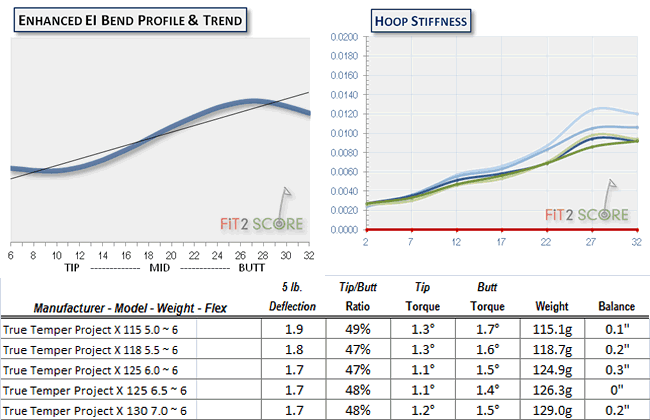Rifle Project X Iron Shaft Review
By Russ Ryden, A Golf Digest America’s 100 Best Clubfitter
Fit2Score, Dallas Fort Worth, Texas

The Precision Rifle Project X has been with us for a very long time. It somehow got missed when I was in the early days of measuring the vast number of shafts in the market. I noticed its absence when I measured the Project X LZ model. It was originally made by Royal Precision Shaft Company in Connecticut. They were acquired by TrueTemper and the production was moved to Tennessee. You will see many of the best players in the world playing this shaft. Compared to a Dynamic Gold X100, it is slightly softer in the butt and stiffer in the Mid. Unlike the TrueTemper Dynamic Gold, the Project X profile is the same for all weight/stiffness variations. The heavier the shaft the stiffer it gets. The profile remains the same for all flex designations.

Shaft stiffness is expressed as a number, 5.0, 5.5, 6.0, 6.5, and 7.0. The numbering system was derived from the Royal Precision Rifle shaft. There was a formula that rated stiffness as a function of frequency and length. That formula and variations of it are still used by some club makers today. The radial consistency of all the review samples was excellent. The labels are placed on one of the stiffness planes. If you are concerned about shaft orientation, label up or label down will work as good as anything. However, the radial quality of all the shafts I measured indicated they could be installed in any orientation. The Project X is known to be easy to load and typically produces a low spin, piercing trajectory.
 In the review of the Project X LZ shaft I introduced a new measurement metric, Set Stiffness Range. I developed the concept as a method of looking at the difference between “Flighted” and standard iron sets. I could see the differences in the charts of wedge and 3i shafts but the vision was hard to quantify.. Adding a number to express the ratio created a new method for understanding the shaft sets I work with. The larger the range, the greater the difference in the shafts contribution to launch variation throughout the set.
In the review of the Project X LZ shaft I introduced a new measurement metric, Set Stiffness Range. I developed the concept as a method of looking at the difference between “Flighted” and standard iron sets. I could see the differences in the charts of wedge and 3i shafts but the vision was hard to quantify.. Adding a number to express the ratio created a new method for understanding the shaft sets I work with. The larger the range, the greater the difference in the shafts contribution to launch variation throughout the set.
As you look at this graphic you will see what I mentioned earlier. The bend profiles of all the models of the Project X do not change with stiffness. You simply find the weight and/or stiffness that feels and performs best for you. But another metric to observe is the increase in the set stiffness range of the 5.0 and 5.5 models. The long irons in these sets will launch higher than one can expect in the heavier, stiffer versions. The idea that irons shafts, which are in fact sets, can be compared by looking only at 6i profiles is shown once again to be lacking.
My friend and mentor, Dave Tutelman posted this comment in another discussion of the shaft stiffness range metric. I cannot express my thoughts about this new metric any better than he did. “A big advantage of “measuring” shaft stiffness by plotting the EI curve is that you can do mathematical operations like this. You chose a simple one, with simple arithmetic. But it isn’t that hard to use a butt-biased weighting function that will predict frequency, or a tip-biased weighting function to predict trajectory height. The combination of a known EI profile and spreadsheet capabilities means it’s just arithmetic. As we understand shafts better, EI will not become obsolete; just the way we use and display it will.”